HOW TO PLAY
VICTORUS
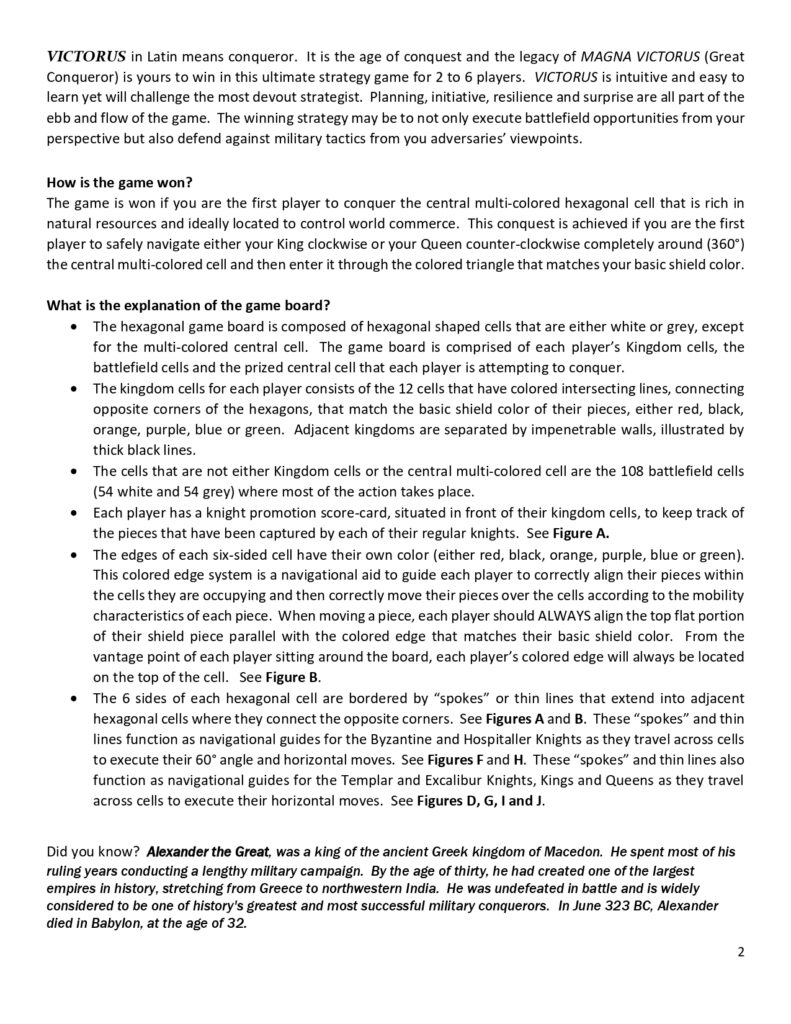
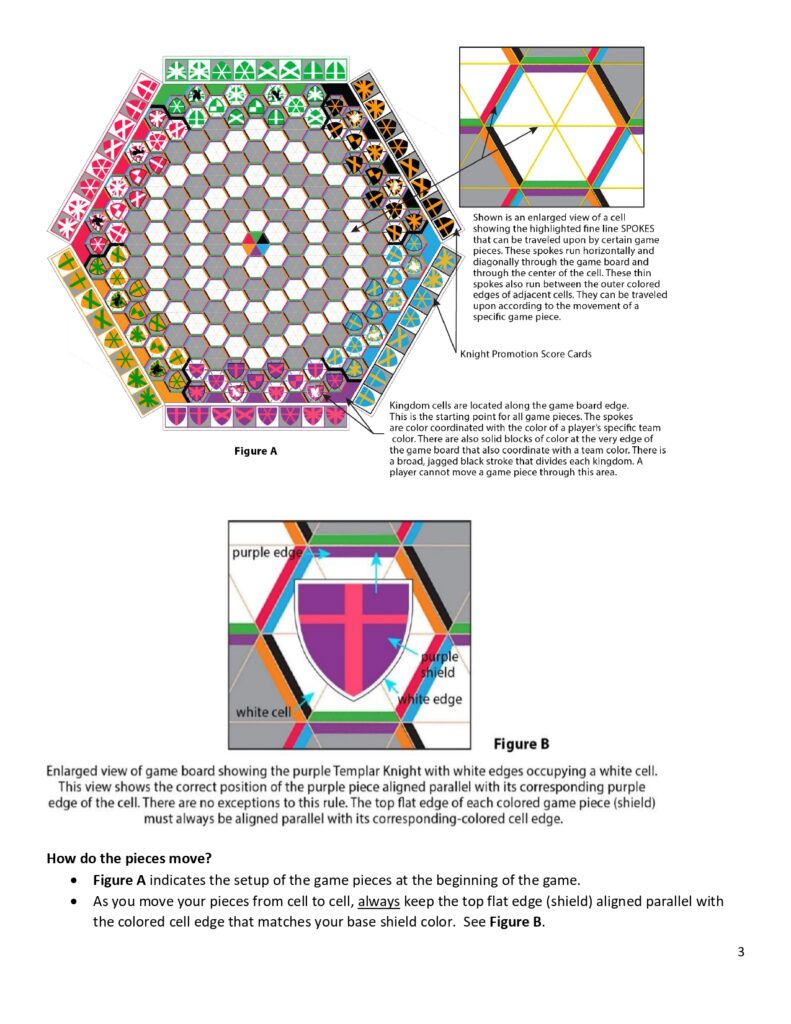
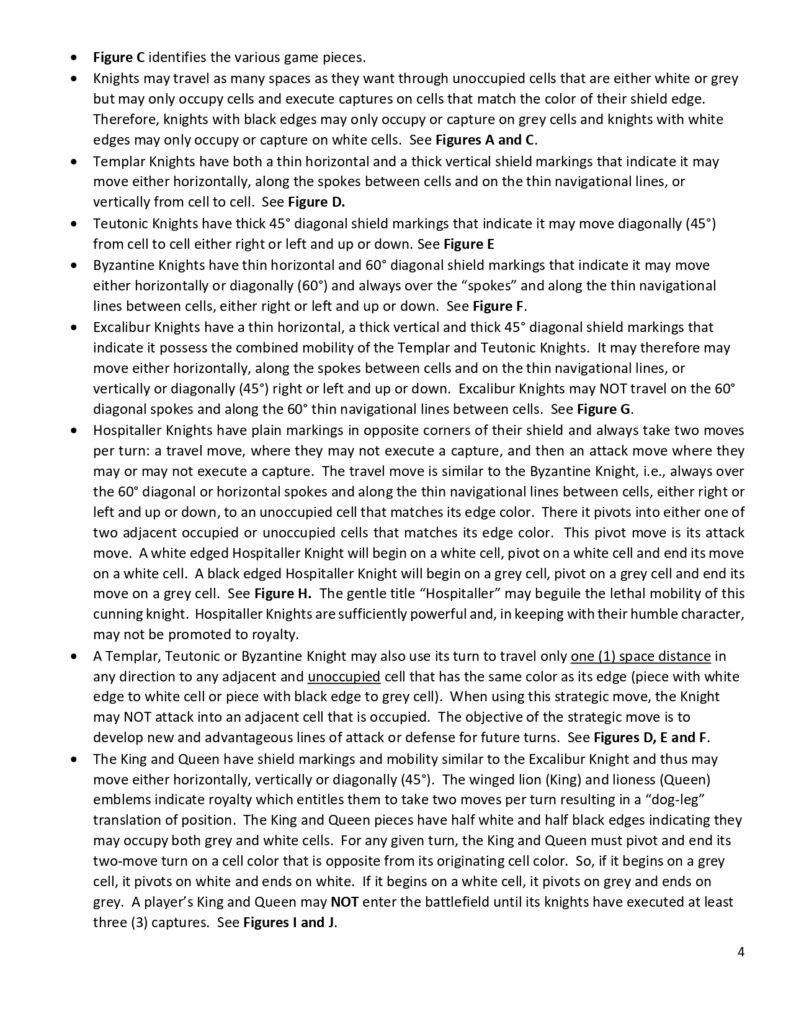
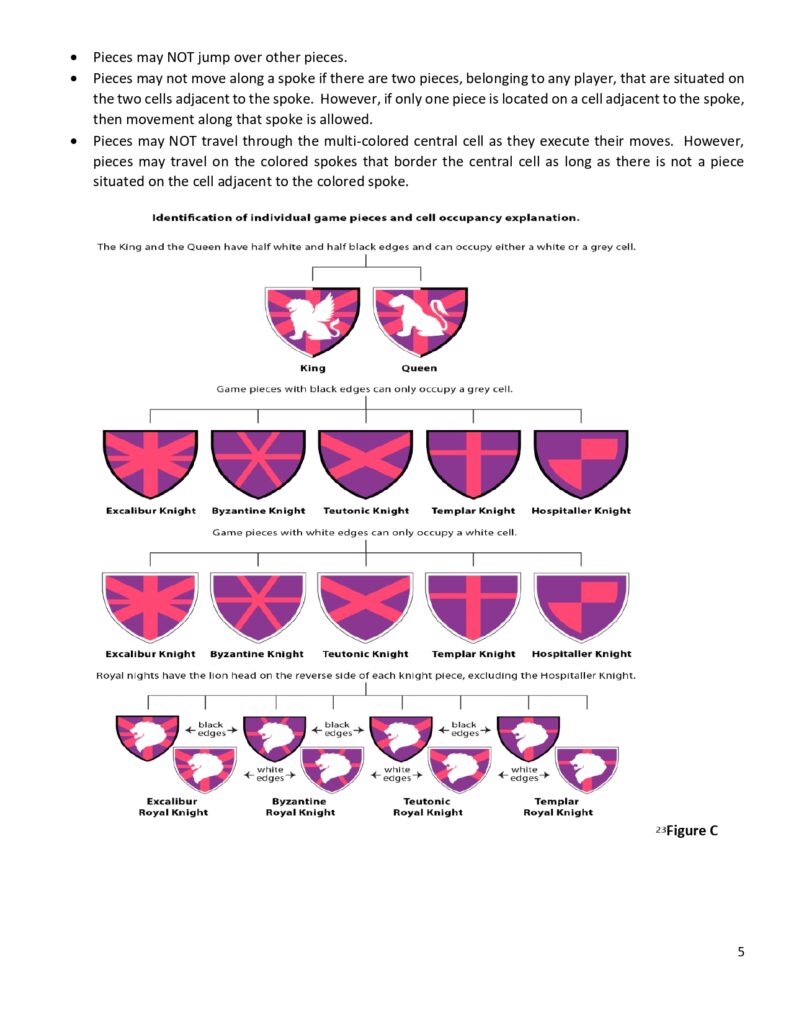
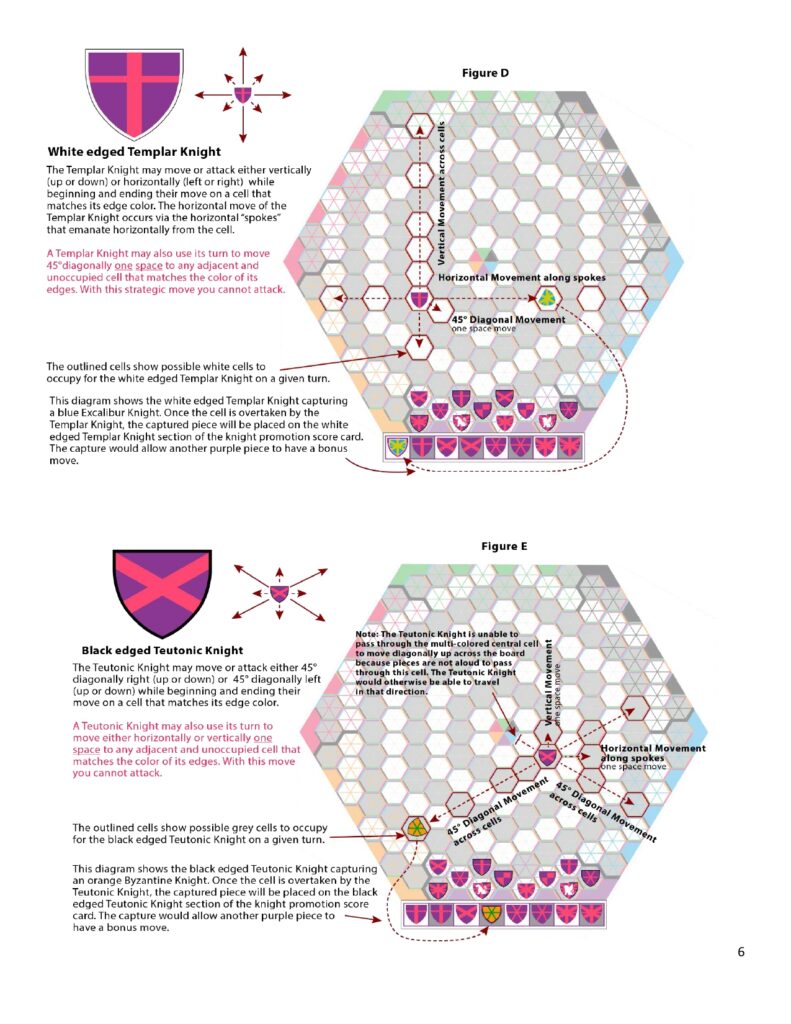
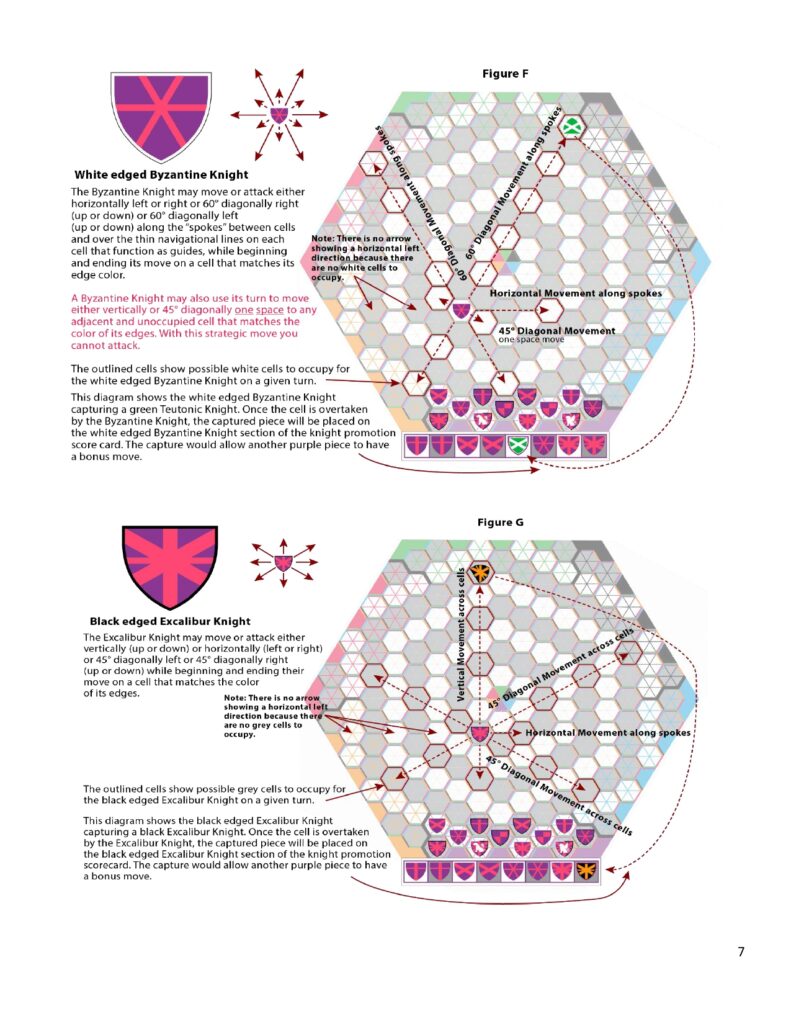
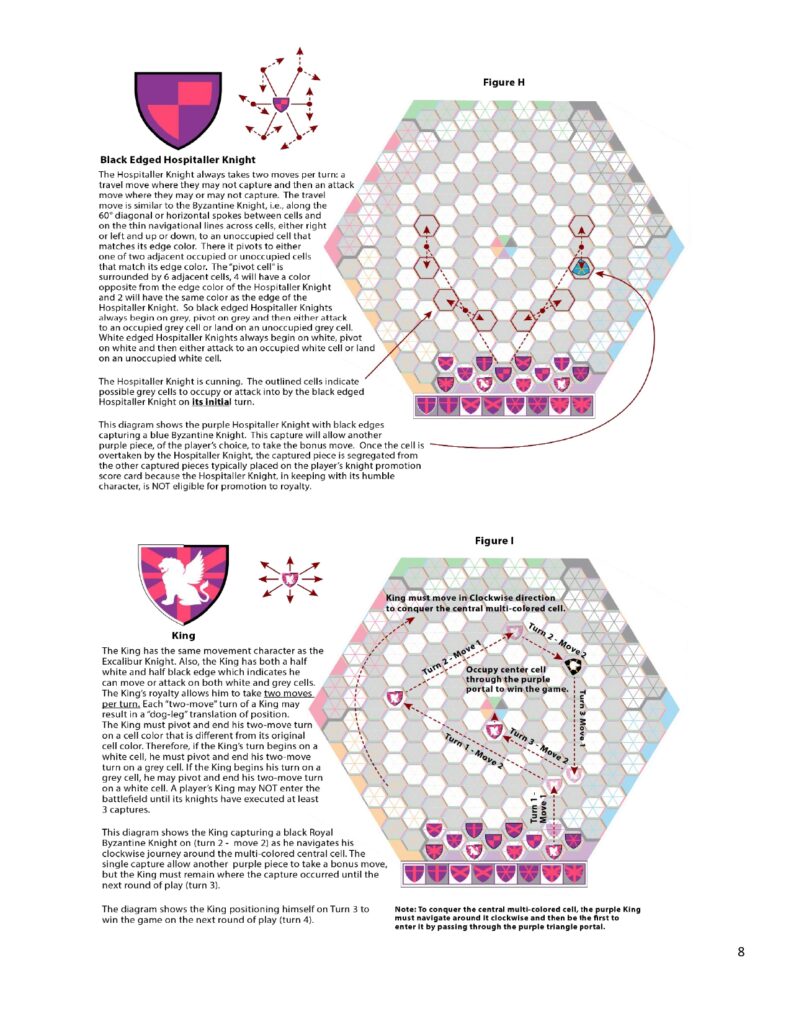
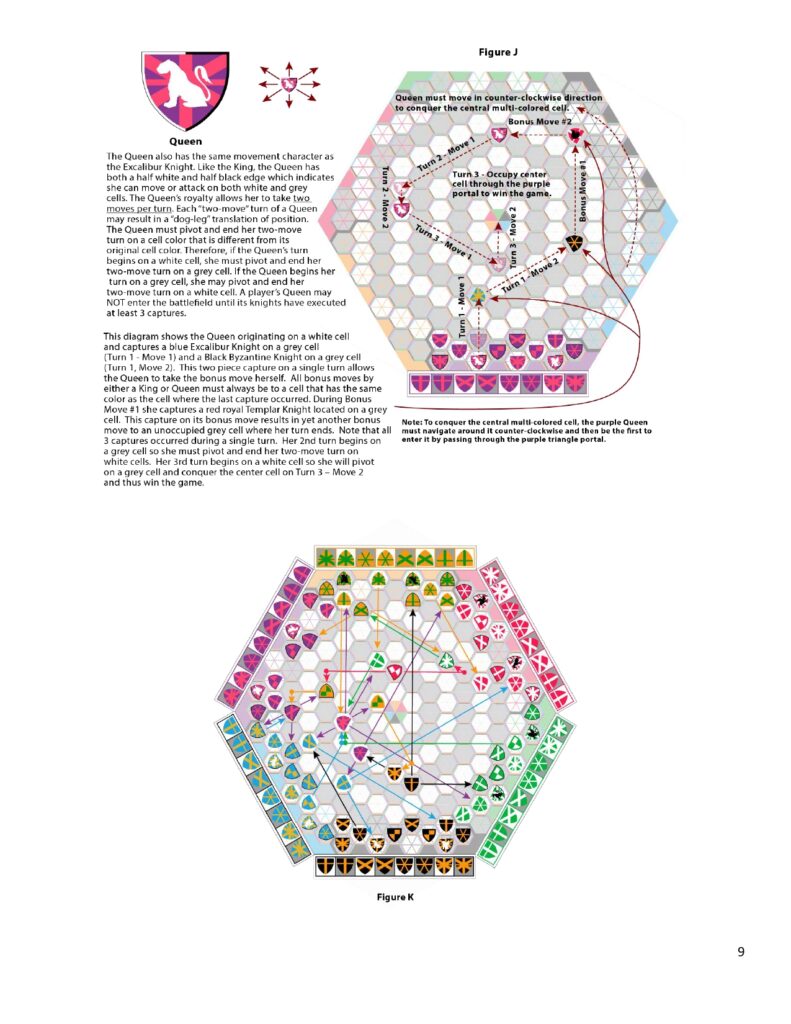
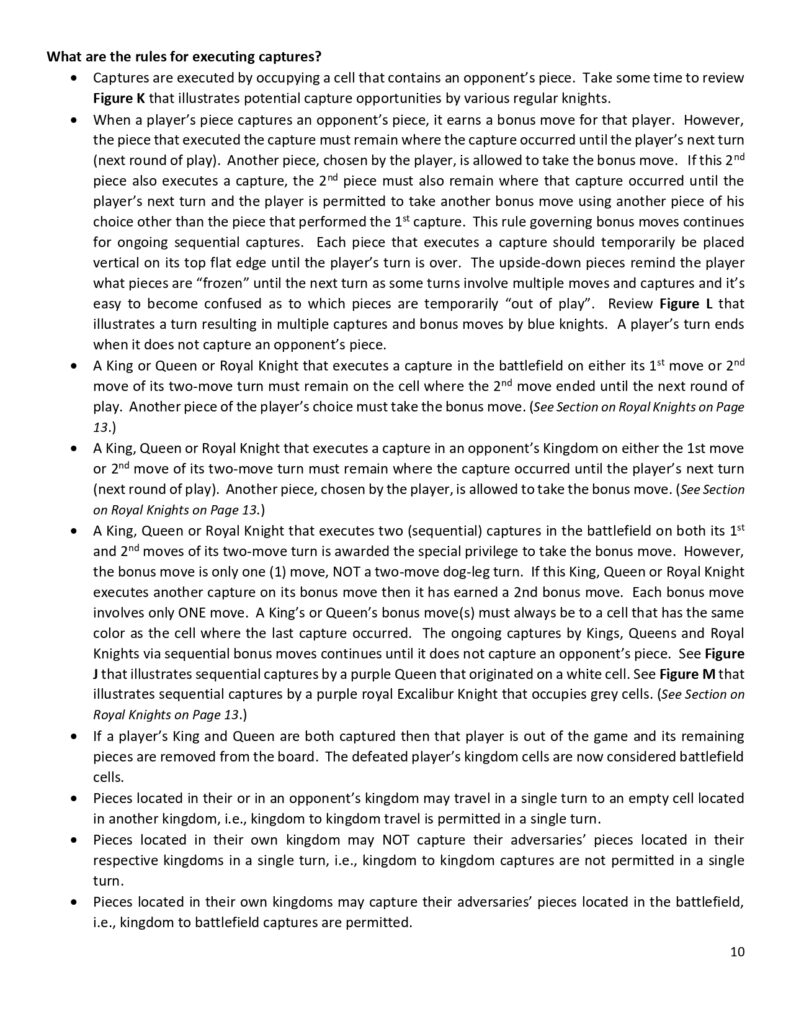
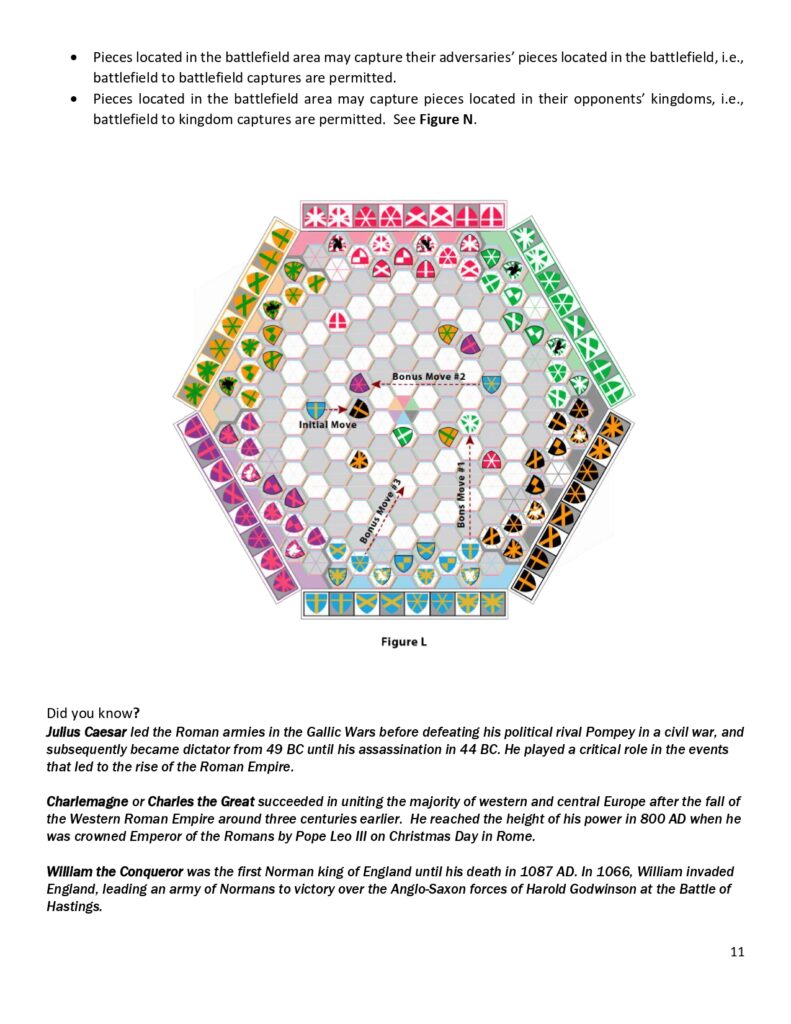
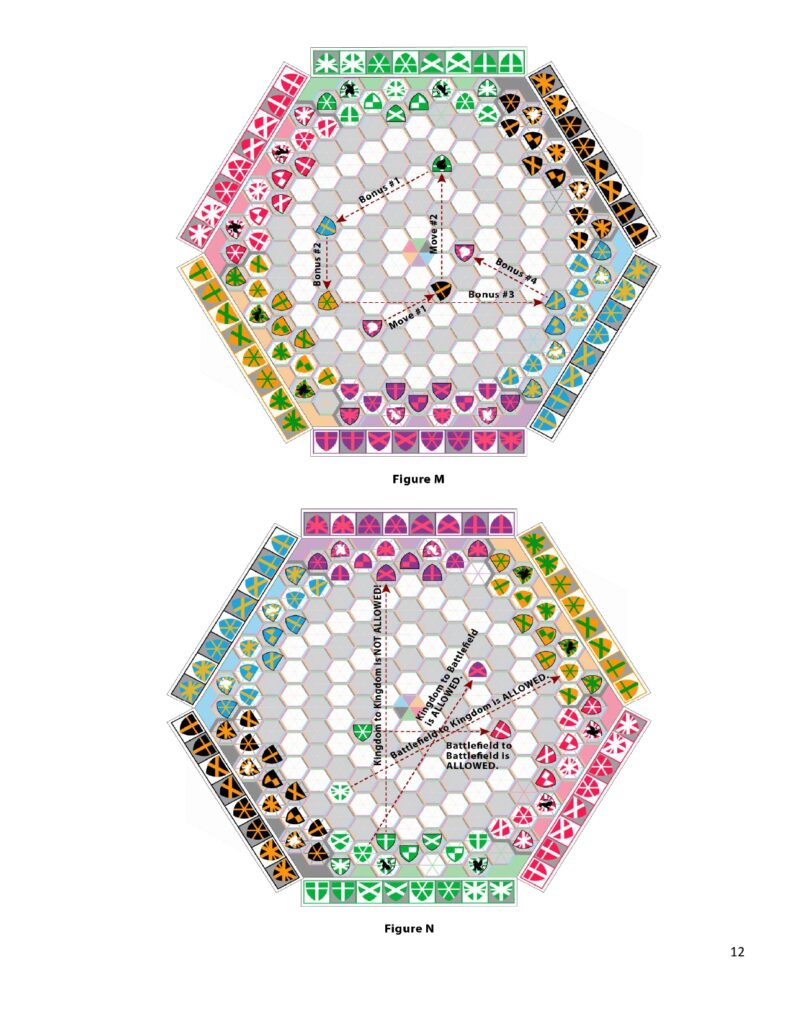
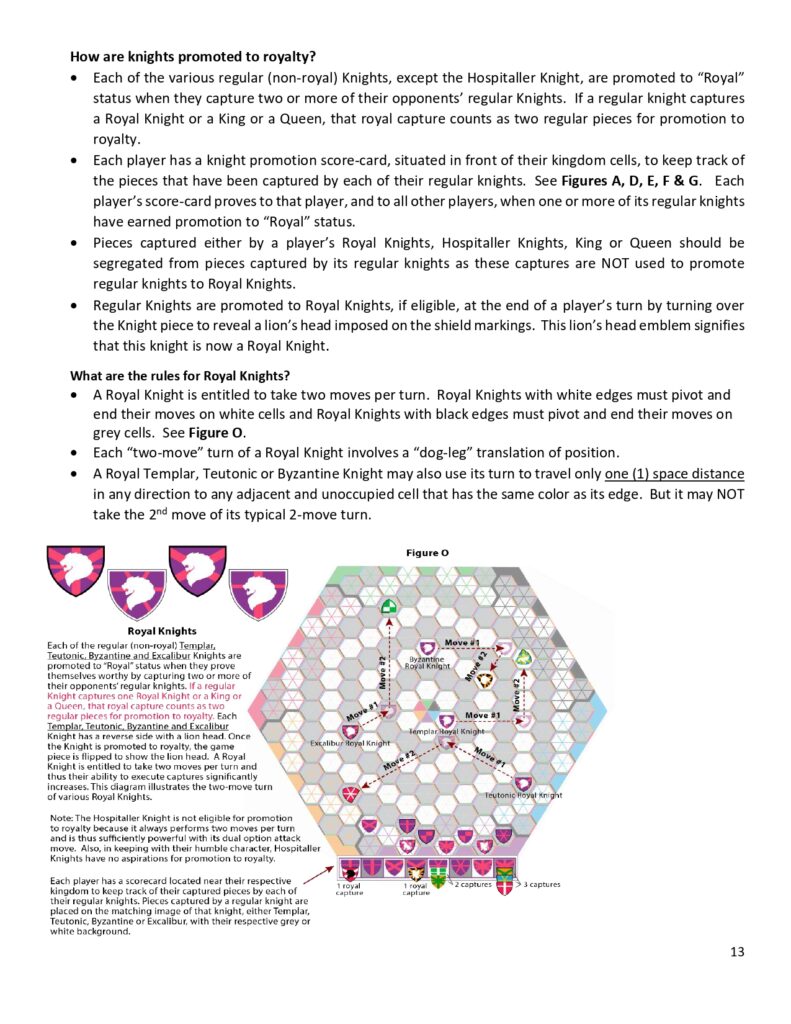
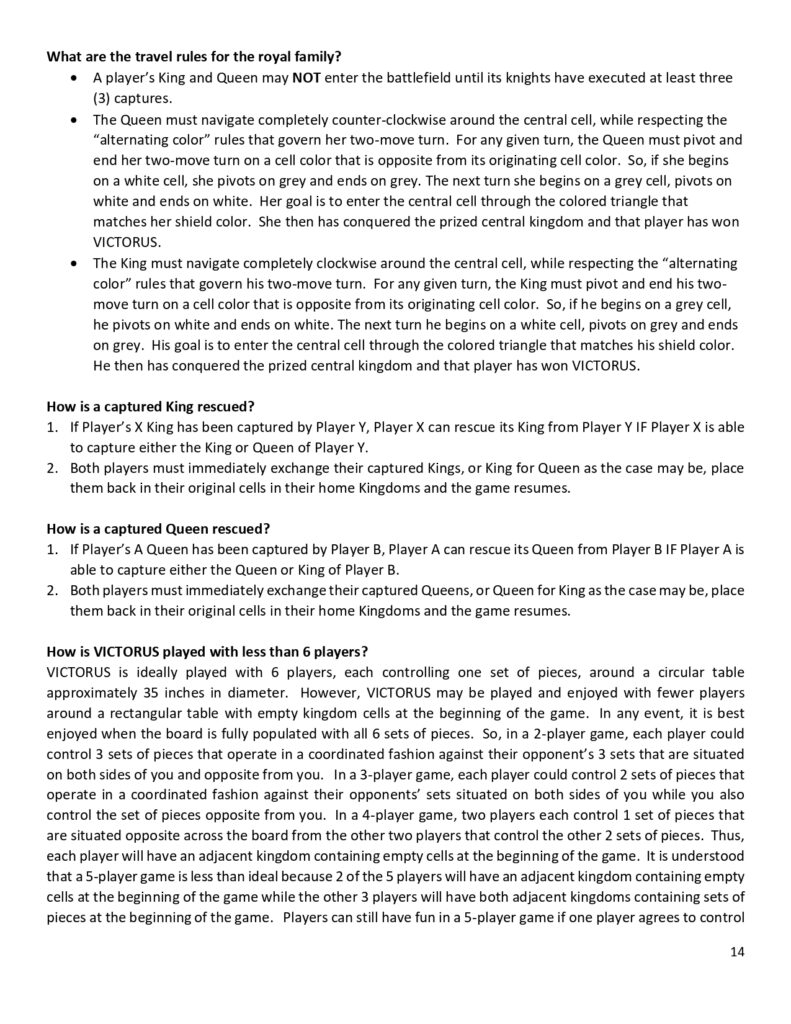
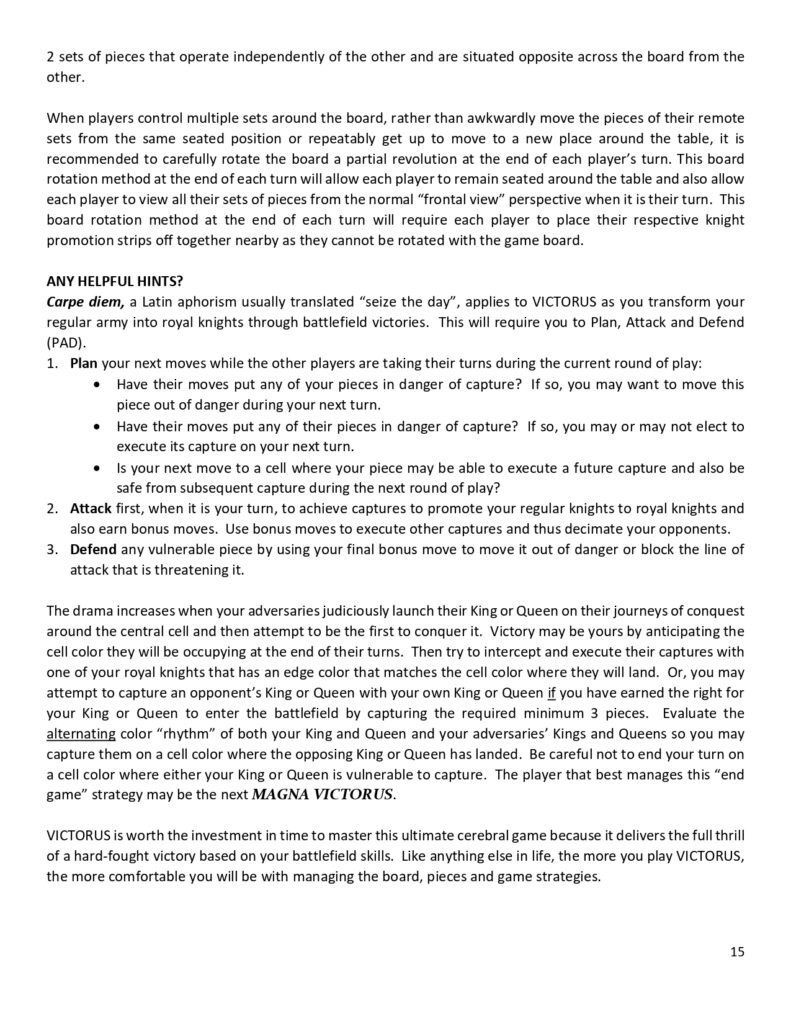
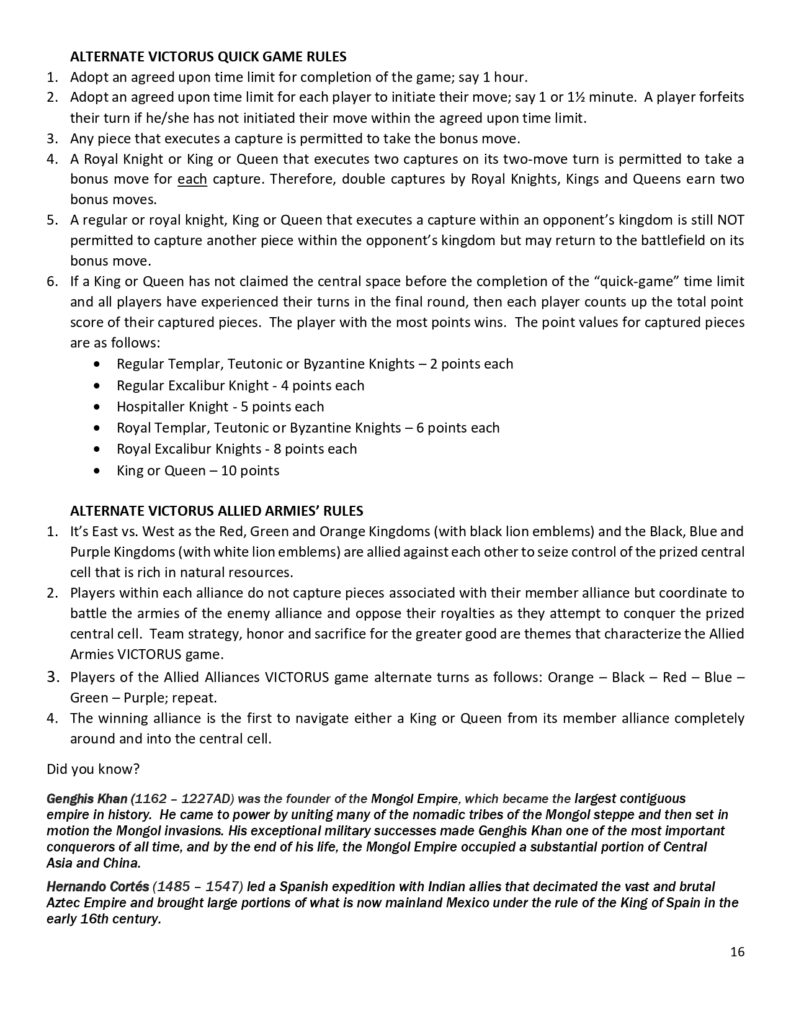
What are the rules for executing captures?
- Captures are executed by occupying a cell that contains an opponent’s Take some time to review Figure K that illustrates potential capture opportunities by various regular knights.
- When a player’s piece captures an opponent’s piece, it earns a bonus move for that However, the piece that executed the capture must remain where the capture occurred until the player’s next turn (next round of play). Another piece, chosen by the player, is allowed to take the bonus move. If this 2nd piece also executes a capture, the 2nd piece must also remain where that capture occurred until the player’s next turn and the player is permitted to take another bonus move using another piece of his choice other than the piece that performed the 1st capture. This rule governing bonus moves continues for ongoing sequential captures. Each piece that executes a capture should temporarily be placed vertical on its top flat edge until the player’s turn is over. The upside-down pieces remind the player what pieces are “frozen” until the next turn as some turns involve multiple moves and captures and it’s easy to become confused as to which pieces are temporarily “out of play”. Review Figure L that illustrates a turn resulting in multiple captures and bonus moves by blue knights. A player’s turn ends when it does not capture an opponent’s piece.
- A King or Queen or Royal Knight that executes a capture in the battlefield on either its 1st move or 2nd move of its two-move turn must remain on the cell where the 2nd move ended until the next round of play. Another piece of the player’s choice must take the bonus (See Section on Royal Knights on Page 13.)
- A King, Queen or Royal Knight that executes a capture in an opponent’s Kingdom on either the 1st move or 2nd move of its two-move turn must remain where the capture occurred until the player’s next turn (next round of play). Another piece, chosen by the player, is allowed to take the bonus move. (See Section on Royal Knights on Page 13.)
- A King, Queen or Royal Knight that executes two (sequential) captures in the battlefield on both its 1st and 2nd moves of its two-move turn is awarded the special privilege to take the bonus move. However, the bonus move is only one (1) move, NOT a two-move dog- leg turn. If this King, Queen or Royal Knight executes another capture on its bonus move then it has earned a 2nd bonus Each bonus move involves only ONE move. A King’s or Queen’s bonus move(s) must always be to a cell that has the same color as the cell where the last capture occurred. The ongoing captures by Kings, Queens and Royal Knights via sequential bonus moves continues until it does not capture an opponent’s piece. See Figure M that illustrates sequential captures by a purple royal Excalibur Knight that occupies grey cells. (See Section on Royal Knights on Page 13.)
- If a player’s King and Queen are both captured then that player is out of the game and its remaining pieces are removed from the board. The defeated player’s kingdom cells are now considered battlefield
- Pieces located in their or in an opponent’s kingdom may travel in a single turn to an empty cell located in another kingdom, i.e., kingdom to kingdom travel is permitted in a single
- Pieces located in their own kingdom may NOT capture their adversaries’ pieces located in their respective kingdoms in a single turn, i.e., kingdom to kingdom captures are not permitted in a single
- Pieces located in their own kingdoms may capture their adversaries’ pieces located in the
battlefield, i.e., kingdom to battlefield captures are permitted.
- Pieces located in the battlefield area may capture their adversaries’ pieces located in the
battlefield, i.e., battlefield to battlefield captures are permitted.
- Pieces located in the battlefield area may capture pieces located in their opponents’
kingdoms, i.e., battlefield to kingdom captures are permitted. See Figure N.
- A King, Queen or Royal Knight that executes two (sequential) captures on its 1st and 2nd moves of its two-move turn is awarded the special privilege to take the bonus move. However, the bonus move is only one (1) move, NOT a two move dog-leg turn. If this King, Queen or Royal Knight executes another capture on its bonus move then it has earned a 2nd bonus move. Each bonus move involves only ONE move. This special rule addressing sequential captures by Kings, Queens and Royal Knights continues until it does not capture an opponent’s piece. See Figure M that illustrates sequential captures by a purple royal Excalibur Knight that may occupy grey A King’s or Queen’s bonus move must always be to a cell that has a color opposite to the previous cell.
- A King, Queen or Royal Knight that executes a capture in an opponent’s Kingdom on the 1st move of its two-move turn may NOT attempt to capture a 2nd piece in the opponent’s Kingdom on its 2nd move. This King, Queen or Royal Knight is permitted to complete its 2nd move to a cell in the battlefield. There it must remain until the next round of play and another piece of the player’s choice may take the earned bonus move. However, if this King, Queen or Royal Knight executes a 2nd capture in the battlefield on its two-move turn, it is awarded the special privilege to take a bonus During its bonus move, this King, Queen or Royal Knight may NOT return to the Kingdom where the initial capture occurred. During its bonus move, it may attempt to capture yet another piece in the battlefield or attempt a capture in a different player’s kingdom.
VICTORUS















MAGNA VICTORUS in Latin means great conqueror. You can be the next great conqueror in this ultimate strategy game for 2 to 6 players. The game is intuitive, fun and easy to learn for players that enjoy 2D recognition, yet will challenge the most devout strategist. Initiative, caution, surprise, and victory are all part of the ebb and flow of the game. The victorious strategy may be to not only see the board from your perspective but to also grasp the battlefield from your adversaries’ viewpoints.
How is the game won?
The game is won if you are the first player to conquer the central multi-colored hexagonal cell. This conquest is achieved if you are the first player to safely navigate either your King clockwise or your Queen counter-clockwise completely around (360°) the central multi-colored hexagonal cell and then enter it through the colored triangle that matches your basic shield color.
What is the explanation of the game board?
- The hexagonal game board is composed of hexagonal shaped cells that are either white or grey, except for the multi-colored central cell. See Figure A. The game board is comprised of each player’s Kingdom cells, the battlefield cells and the prized central cell that each player’s King is attempting to The kingdom for each player consists of the 12 cells that have colored intersecting lines, connecting opposite corners of the hexagons, that match the basic shield color of their pieces, either red, black, orange, purple, blue or green. Adjacent kingdoms are separated by impenetrable walls, illustrated by thick black lines.
- The cells that are not either Kingdom cells or the central multi-colored cell are the 108 battlefield cells (54 white and 54 grey) where most of the action takes place.
- Each edge of each six-sided cell has its own color (either red, black, orange, purple, blue or green). This colored edge system is a navigational aid to guide each player to correctly align their pieces within the cells they are occupying and then correctly move their pieces over the cells according to the mobility characteristics of each See Figure B.
- Each cell has thin lines that connect the opposite corners of the hexagonal See Figure
- A. These thin lines function as navigational guides for the Byzantine Knights as they travel across cells to execute their 60° angle and horizontal moves. See Figure F. These thin lines also function as navigational guides for the Templar and Excalibur Knights, Kings and Queens as they travel across cells to execute their horizontal moves. See Figures D, G, I and J.
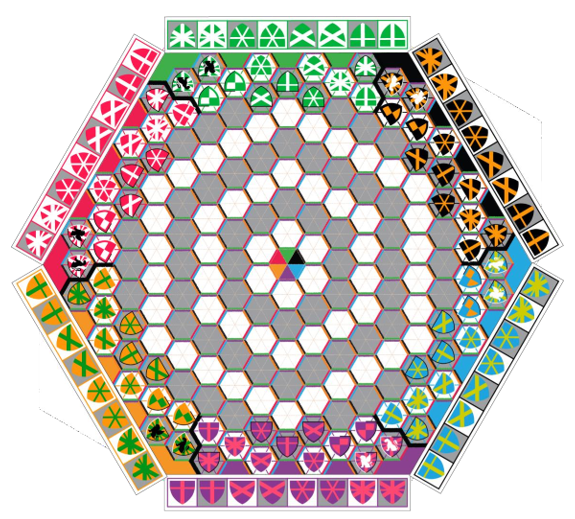
Figure A
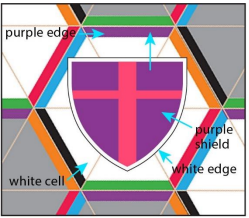
Figure B
Enlarged view of game board showing the purple Templay knight with white edge occupying a white cell. This view shoes the correct position of the purple piece aligned parallel with is corresponding purple edge of the cell. There are no exceptions to this rule. The top flat edge of each colored game piece (Shield) must always be aligned parallel with its corresponding-colored cell edge.
How do the pieces move?
- Figure A indicates the setup of the game pieces at the beginning of the
- As you move your pieces from cell to cell, always keep the top flat edge (shield) aligned parallel with the colored cell edge that matches your base shield See Figure B.
- Figure C identifies the various game
- Knights may travel as many spaces as they want through unoccupied cells that are either white or grey but may only occupy cells and execute captures on cells that match the color of their shield edge. Therefore, knights with black edges may only occupy and capture on grey cells and knights with white edges may only occupy and capture on white cells. See Figures A and C.
- Templar Knights have both a thin horizontal and a thick vertical shield markings that indicate it may move either horizontally, along the spokes between cells and on the thin navigational lines, or vertically from cell to See Figure D.
- Teutonic Knights have thick 45° diagonal shield markings that indicate it may move diagonally (45°) from cell to cell either right or left and up or See Figure E
- Byzantine Knights have thin horizontal and 60° diagonal shield markings that indicate it may move either horizontally or diagonally (60°) and always over the “spokes” between cells and on the thin navigational lines, either right or left and up or See Figure F.
- Excalibur Knights have a thin horizontal, a thick vertical and thick 45° diagonal shield markings that indicate it possess the combined mobility of the Templar and Teutonic It may therefore may move either horizontally, along the spokes between cells and on the thin navigational lines, or vertically or diagonally (45°) right or left and up or down. Excalibur Knights may NOT travel on the 60° diagonal spokes or on the 60° thin navigational lines between cells. See Figure G.
- Hospitaller Knights have plain markings in opposite corners of their shield and always take two moves per turn: a travel move and then an attack move. The travel move is similar to the Byzantine Knight, i.e., always over the 60° diagonal or horizontal spokes between cells and on the thin navigational lines, either right or left and up or down, to an unoccupied cell that matches its edge color. There it pivots into either one of two adjacent occupied or unoccupied cells that matches its edge color. This pivot move is its attack move. See Figure H. The gentle title “Hospitaller” may beguile the lethal mobility of this cunning knight. Hospitaller Knights are sufficiently powerful and, in keeping with their humble character, may not be promoted to
- A Templar, Teutonic or Byzantine Knight may also use its turn to travel only one (1) space distance in any direction to any adjacent and unoccupied cell that has the same color as its edge (piece with white edge to white cell or piece with black edge to grey cell). When using this strategic move, the Knight may NOT attack into an adjacent cell that is occupied. The objective of the strategic move is to develop new and advantageous lines of attack or defense for future See Figures D, E and F.
- The King and Queen have shield markings and mobility similar to the Excalibur Knight and thus may move either horizontally, vertically or diagonally (45°). The winged lion (King) and lioness (Queen) emblems indicate royalty which entitles them to take two moves per turn resulting in a “dog-leg” translation of position. The King and Queen pieces have half white and half black edges indicating they may occupy both grey and white cells. For any given turn, the King and Queen must pivot and end its two-move turn on a cell color that is opposite from its originating cell color. So, if it begins on a grey cell, it pivots on white and ends on white. If it begins on a white cell, it pivots on grey and ends on grey. A player’s King and Queen may not enter the battlefield until its knights have executed at least three (3) See Figures I and J.
- Pieces may NOT jump over other
- Pieces may not move along a spoke if there are two pieces, belonging to any player, that are situated on the two cells adjacent to the spoke. However, if only one piece is located on a cell adjacent to the spoke, then movement along that spoke is allowed.
- Pieces may NOT travel through the multi-colored central cell as they execute their moves. However, pieces may travel on the colored spokes that border the central cell as long as there is not a piece situated on the cell adjacent to the colored spoke.
Identification of individual game piece and cell occupancy explanation
The King and the Queen have half white and half black edges and can occupy either a white or a grey call.

King
Queen
Game piece with black edges can only occupy a grey cell.

Excalibur Knight
Byzantine Knight
Teutonic Knight
Templar Knight
Hospitaller Knight
Game piece with white edges can only occupy a white cell

Excalibur Knight
Byzantine Knight
Teutonic Knight
Templar Knight
Hospitaller Knight
Royal nights have the lion head in the reverse side of each knight piece, excluding the Hospitaller Knight.

Excalibur Royal Knight
Byzantine Royal Knight
Teutonic Royal Knight
Templar Royal Knight
Figure C


White edged Templar Knight
The Templar Knight may move or attack either vertically
(up or down) or horizontally (left or right) while
beginning and ending their move on a cell that
matches its edge color. The horizontal move of the
Templar Knight occurs via the horizontal “spokes”
that emanate horizontally from the cell.
A Templar Knight may also use its turn to move
45°diagonally one space to any adjacent and
unoccupied cell that matches the color of its
edges. With this strategic move you cannot attack.
The outlined cells show possible white cells to occupy for the white edged Templar Knight on a given turn.
This diagram shows the white edged Templar Knight capturing
a blue Excalibur Knight. Once the cell is overtaken by the
Templar Knight, the captured piece will be placed on the white
edged Templar Knight section of the knight promotion score card.
The capture would allow another purple piece to have a bonus move.
Figure D
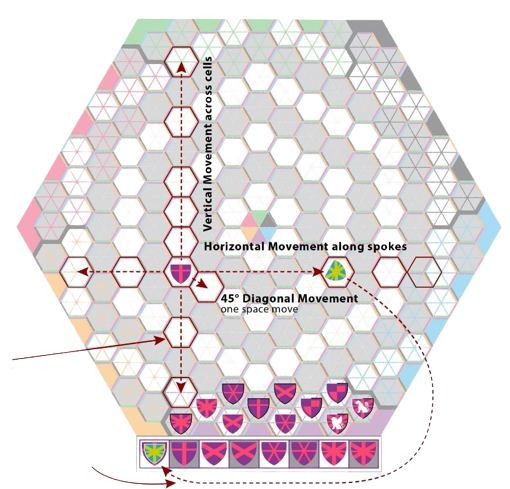


Black edged Teutonic Knight
The Teutonic Knight may move or attack either 45′
diagonally right (up or 450 diagonally left
(up or down) While beginning and ending their
on a cell that matches its edge color.
A Teutonic Knight may also use its tum to either horizontally or vertically to any adjacent and unoccupied cell that matches the color of its edges. With this move cannot attack.
The outlined cells show possible grey cells to occupy for the black edged Templar Knight on a given turn.
This diagram Shows the black edged Teutonic Knight capturirvg
an orange Byzantine Knight. Once the cell is overtaken by the
Knight. the piæ will placed on the black , edged Teutonic Knight section Of the knight promotion score card. The capture would allow another purple piece to a bonus move,
Figure E



The outlined cells show possible white cells to occupy for
the white edged Byzantine Knight on a given turn.
This diagram shows the white edged Byzantine Knight
capturing a green Teutonic Knight. Once the cell is overtaken
by the Byzantine Knight, the captured piece will be placed on
the white edged Byzantine Knight section of the knight promotion
score card. The capture would allow another purple piece to have a bonus move.
Figure F



Black edged Excalibur Knight
The Excalibur Knight may move or attack either
vertically (up or down) or horizontally (left or right)
or 450 diagonally left or 450 diagonally right
(up or down) while beginning and ending their
move on a cell that matches the color
of its edges.
The outlined cells show possible grey cells to occupy for
the black edged Excalibur Knight on a given turn.
This diagram shows the black edged Excalibur Knight
capturing a black Excalibur Knight. Once the cell is overtaken
by the Excalibur Knight, the captured piece will be placed on
the black edged Excalibur Knight section of the knight promotion
scorecard. The capture would allow another purple piece to have
a bonus move.
Figure G



Black Edged Hospitaller Knight
The Hospitaller Knight typically takes two moves per turn: a travel move and then an attack move. The travel move is similar to the Byzantine Knight, i.e. along the 600 diagonal Or horizontal spokes between cells and On the thin navigational lines across cells, either right or left and up or down, to an unoccupied cell that matches its edge color. There it pivots to either one of two adjacent occupied or unoccupied cells that match its edge color. The “pivot cell” is surrounded by 6 *djacent cells, 4 Will have a color opposite from the edge color of the Hospitaller Knight and 2 will have same color as the edge of the Hospitaller Knight. So black edged Hospitaller Knights always begin on grey, pivot on grey and then either attack to an occupied cell or land on an unoccupied grey cell. White edged Hospitaller Knights always begin on White, pivot on White and then either attack to an occupied white cell or unoccupied white cell
This diagram shows the possible attack possibilities of the purple Guard to protect the King and Queen from opponent pieces who are positioned to attack. A capture for a Guard results in a bonus move to be performed by another purple piece, but the Guard must remain where the capture occurred until the next round of play.
Figure H



King
The King has the same movement character as the Excalibur Knight. Also, the King has both a half white and half black edge which King The King has the same movement character as the Excalibur Knight. Also, the King has both a half white and half black edge which indicates he can move or attack on both white and grey cells. The King’s royalty allows him to take two moves per turn. Each “two-move” turn ofa King may result in a “dog-leg” translation of position. The King must pivot and end his two-move turn on a cell color that is different from its original cell color. Therefore, if the King’s turn begins on a white cell, he must pivot and end his two-move turn on a grey cell. If the King begins his turn on a grey cell, he may pivot and end his two-move turn on a white cell.
This diagram shows the King capturing a black Royal Byzantine Knight on (turn 2- move 2) as he navigate his clockwise journey around the multi-colored central cell. The single capture allow another purple piece to take a bonus move, but the king must remain where the capture occurred until the next round of play (turn 3).
The diagram shows the king positioning himself on turn 3 to win the game on the next round of play (turn 4).
Figure I

Note : to conquer the central multi-colored cell, the purple King must navigate around it clockwise and them be the first to enter it by passing through the purple triangle portal.


Queen
The Queen also has the same movement character as the Excalibur Knight. Like the King, the Queen has both a half white and half black edge which indicates she can move or attack on both white and grey cells. The Queen’s royalty allows her to take two moves per turn. Each “two move” turn of a Queen may result in a “dog-leg” translation of position. The Queen must pivot and end her two-move turn on a cell color that is different from its original cell color. Therefore, if the Queen’s turn begins on a white cell, she must pivot and end her two-move turn on a grey cell. If the Queen begins her
turn on a grey cell, she may pivot and end her two-move turn on a white cell.
This diagram shows the Queen originating on a white cell and capture a blue excalibur Knight on a grey cell (Turn 1 – Move -1 ) and a black Byzantine Knight on a grey cell (Turn 1 – Move 2). This two piece captured on a single turn allows the Queen to take bonus move herself. All bonus moves by either a king or Queen must always be to a cell that has the same color as the cell where the last captured occurred. During Bonus Move # 1 she captured a red royal Templar Knight located on a grey cell. This captures on its bonus move results in yet another bonus move to an unoccupied grey cell where her turn ends. Note that all 3 captures occurred during a single turn. Her 2nd turn begins on a grey cell so she must pivot and end her two-move on white cells. Her 3rd turn begins on a white cell se she will pivot on a grey cell and conquer the center cell on turn 3 – Move 2 and thus win the game.
Figure J
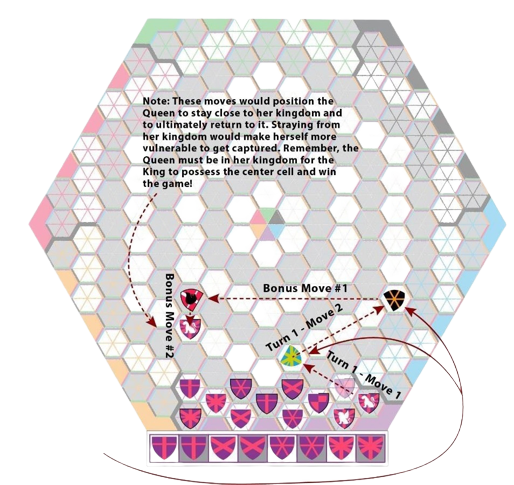
Note : to conquer the central multi-colored cell, the purple Queen must navigate around it counter-clockwise and then be the first to enter it by passing through the purple triangle portal.

Figure K
What are the rules for executing captures?
- Captures are executed by occupying a cell that contains an opponent’s Take some time to review Figure K that illustrates potential capture opportunities by various regular knights.
- When a player’s piece captures an opponent’s piece, it earns a bonus move for that However, the piece that executed the capture must remain where the capture occurred until the player’s next turn (next round of play). Another piece, chosen by the player, is allowed to take the bonus move. If this 2nd piece also executes a capture, the 2nd piece must also remain where that capture occurred until the player’s next turn and the player is permitted to take another bonus move using another piece of his choice other than the piece that performed the 1st capture. This rule governing bonus moves continues for ongoing sequential captures. Each piece that executes a capture should temporarily be placed vertical on its top flat edge until the player’s turn is over. The upside-down pieces remind the player what pieces are “frozen” until the next turn as some turns involve multiple moves and captures and it’s easy to become confused as to which pieces are temporarily “out of play”. Review Figure L that illustrates a turn resulting in multiple captures and bonus moves by blue knights. A player’s turn ends when it does not capture an opponent’s piece.
- A King or Queen or Royal Knight that executes a capture in the battlefield on either its 1st move or 2nd move of its two-move turn must remain on the cell where the 2nd move ended until the next round of play. Another piece of the player’s choice must take the bonus (See Section on Royal Knights on Page 13.)
- A King, Queen or Royal Knight that executes a capture in an opponent’s Kingdom on either the 1st move or 2nd move of its two-move turn must remain where the capture occurred until the player’s next turn (next round of play). Another piece, chosen by the player, is allowed to take the bonus move. (See Section on Royal Knights on Page 13.)
- A King, Queen or Royal Knight that executes two (sequential) captures in the battlefield on both its 1st and 2nd moves of its two-move turn is awarded the special privilege to take the bonus move. However, the bonus move is only one (1) move, NOT a two-move dog- leg turn. If this King, Queen or Royal Knight executes another capture on its bonus move then it has earned a 2nd bonus Each bonus move involves only ONE move. A King’s or Queen’s bonus move(s) must always be to a cell that has the same color as the cell where the last capture occurred. The ongoing captures by Kings, Queens and Royal Knights via sequential bonus moves continues until it does not capture an opponent’s piece. See Figure M that illustrates sequential captures by a purple royal Excalibur Knight that occupies grey cells. (See Section on Royal Knights on Page 13.)
- If a player’s King and Queen are both captured then that player is out of the game and its remaining pieces are removed from the board. The defeated player’s kingdom cells are now considered battlefield
- Pieces located in their or in an opponent’s kingdom may travel in a single turn to an empty cell located in another kingdom, i.e., kingdom to kingdom travel is permitted in a single
- Pieces located in their own kingdom may NOT capture their adversaries’ pieces located in their respective kingdoms in a single turn, i.e., kingdom to kingdom captures are not permitted in a single
- Pieces located in their own kingdoms may capture their adversaries’ pieces located in the
battlefield, i.e., kingdom to battlefield captures are permitted.
- Pieces located in the battlefield area may capture their adversaries’ pieces located in the
battlefield, i.e., battlefield to battlefield captures are permitted.
- Pieces located in the battlefield area may capture pieces located in their opponents’
kingdoms, i.e., battlefield to kingdom captures are permitted. See Figure N.
What are the rules for executing captures?
- Captures are executed by occupying a cell that contains an opponent’s Take some time to review Figure K that illustrates potential capture opportunities by various regular knights.
- When a player’s piece captures an opponent’s piece, it earns a bonus move for that However, the piece that executed the capture must remain where the capture occurred until the player’s next turn (next round of play). Another piece, chosen by the player, is allowed to take the bonus move. If this 2nd piece also executes a capture, the 2nd piece must also remain where that capture occurred until the player’s next turn and the player is permitted to take another bonus move using another piece of his choice other than the piece that performed the 1st capture. This rule governing bonus moves continues for ongoing sequential captures. Each piece that executes a capture should temporarily be placed vertical on its top flat edge until the player’s turn is over. The upside-down pieces remind the player what pieces are “frozen” until the next turn as some turns involve multiple moves and captures and it’s easy to become confused as to which pieces are temporarily “out of play”. Review Figure L that illustrates a turn resulting in multiple captures and bonus moves by blue knights. A player’s turn ends when it does not capture an opponent’s piece.
- A King or Queen or Royal Knight that executes a capture in the battlefield on either its 1st move or 2nd move of its two-move turn must remain on the cell where the 2nd move ended until the next round of play. Another piece of the player’s choice must take the bonus (See Section on Royal Knights on Page 13.)
- A King, Queen or Royal Knight that executes a capture in an opponent’s Kingdom on either the 1st move or 2nd move of its two-move turn must remain where the capture occurred until the player’s next turn (next round of play). Another piece, chosen by the player, is allowed to take the bonus move. (See Section on Royal Knights on Page 13.)
- A King, Queen or Royal Knight that executes two (sequential) captures in the battlefield on both its 1st and 2nd moves of its two-move turn is awarded the special privilege to take the bonus move. However, the bonus move is only one (1) move, NOT a two-move dog- leg turn. If this King, Queen or Royal Knight executes another capture on its bonus move then it has earned a 2nd bonus Each bonus move involves only ONE move. A King’s or Queen’s bonus move(s) must always be to a cell that has the same color as the cell where the last capture occurred. The ongoing captures by Kings, Queens and Royal Knights via sequential bonus moves continues until it does not capture an opponent’s piece. See Figure M that illustrates sequential captures by a purple royal Excalibur Knight that occupies grey cells. (See Section on Royal Knights on Page 13.)
- If a player’s King and Queen are both captured then that player is out of the game and its remaining pieces are removed from the board. The defeated player’s kingdom cells are now considered battlefield
- Pieces located in their or in an opponent’s kingdom may travel in a single turn to an empty cell located in another kingdom, i.e., kingdom to kingdom travel is permitted in a single
- Pieces located in their own kingdom may NOT capture their adversaries’ pieces located in their respective kingdoms in a single turn, i.e., kingdom to kingdom captures are not permitted in a single
- Pieces located in their own kingdoms may capture their adversaries’ pieces located in the
battlefield, i.e., kingdom to battlefield captures are permitted.
- Pieces located in the battlefield area may capture their adversaries’ pieces located in the
battlefield, i.e., battlefield to battlefield captures are permitted.
- Pieces located in the battlefield area may capture pieces located in their opponents’
kingdoms, i.e., battlefield to kingdom captures are permitted. See Figure N.
- A King, Queen or Royal Knight that executes two (sequential) captures on its 1st and 2nd moves of its two-move turn is awarded the special privilege to take the bonus move. However, the bonus move is only one (1) move, NOT a two move dog-leg turn. If this King, Queen or Royal Knight executes another capture on its bonus move then it has earned a 2nd bonus move. Each bonus move involves only ONE move. This special rule addressing sequential captures by Kings, Queens and Royal Knights continues until it does not capture an opponent’s piece. See Figure M that illustrates sequential captures by a purple royal Excalibur Knight that may occupy grey A King’s or Queen’s bonus move must always be to a cell that has a color opposite to the previous cell.
- A King, Queen or Royal Knight that executes a capture in an opponent’s Kingdom on the 1st move of its two-move turn may NOT attempt to capture a 2nd piece in the opponent’s Kingdom on its 2nd move. This King, Queen or Royal Knight is permitted to complete its 2nd move to a cell in the battlefield. There it must remain until the next round of play and another piece of the player’s choice may take the earned bonus move. However, if this King, Queen or Royal Knight executes a 2nd capture in the battlefield on its two-move turn, it is awarded the special privilege to take a bonus During its bonus move, this King, Queen or Royal Knight may NOT return to the Kingdom where the initial capture occurred. During its bonus move, it may attempt to capture yet another piece in the battlefield or attempt a capture in a different player’s kingdom.
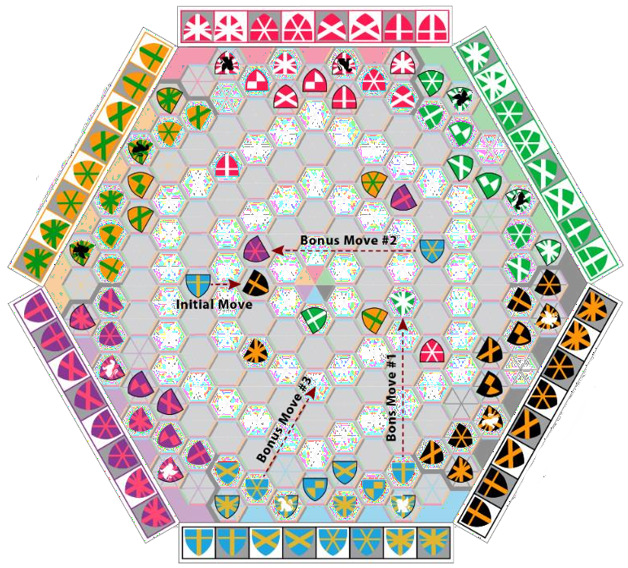
Figure L

Figure M

Figure N
How are knights promoted to royalty?
- Each of the various regular (non-royal) Knights, except the Hospitaller Knight, are promoted to “Royal” status when they capture two or more of their opponents’ regular If a regular knight captures a Royal Knight or a King or a Queen, that royal capture counts as two regular pieces for promotion to royalty.
- Each player has a knight promotion score-card to keep track of their captured pieces for each of their knights. See Figures A, D, E, F & G. Each player’s score-card proves to that player, and to all other players, when one or more of its regular knights have earned promotion to “Royal”
- Pieces captured either by a player’s Royal Knights, Hospitaller Knights, King or Queen are segregated from pieces captured by its regular knights as these captures are not used for Royal Knight
- Regular Knights are promoted to Royal Knights, if eligible, at the end of a player’s turn by turning over the Knight piece to reveal a lion’s head imposed on the shield This lion’s head emblem signifies that this knight is now a Royal Knight.
How are the rules for Royal Knights
- A Royal Knight is entitled to take two moves per turn. See Figure O. Royal Knights with white edges must pivot and end their moves on white cells and Royal Knights with black edges must pivot and end their moves on grey cells.
- Each “two-move” turn of a Royal Knight involves a “dog-leg” translation of position.
- A Royal Templar, Teutonic or Byzantine Knight may also use its turn to travel only one (1) space distance in any direction to any adjacent and unoccupied cell that has the same color as its edge. But it may NOT take the 2nd move of its typical 2-move turn




Royal Knights
Each of the regular (non-royal) Templar. Teutonic. Byzantine and Excalibur Knights are promoted to “Royal” status when they prove themselves worthy by capturing two or more of their opponents’ regular knights.
If a regular Knight captures one Royal Knight or a King or a Queen, that royal capture counts as two regular pieces for promotion to royalty.
Each Templar. Teutonic. Byzantine and Excalibur night has a reverse side with a lion head. On he Knight is promoted to royalty, the game piece is flipped to show the lion head. A Royal Knight is entitled to take two moves per turn thus their ability to execute captures significantty increases. This diagram illustrates the Of various Royal Knights.
Note: The Hospitaller Knight is not eligible for promotion to royalty because it always performs two moves per to and is thus sufficiently powerful with its dual option attack move. Also, in keeping with their humble character, Hospitaller Knights have no aspirations for promotion to royalty.
Each player has a scorecard located near their respective kingdom to keep track of their captured pieces by each of their regular knights. Pieces captured by a regular knight are placed on the matching image of that knight, either Templar, Teutonic, Byzantine or Excalibur, with their respective grey or white background.
Figure O

What are the travel rules for the royal family?
- The Queen must navigate completely counter-clockwise around the central cell, while respecting the “alternating color” rules that govern her two-move turn. For any given turn, the Queen must pivot and end her two-move turn on a cell color that is opposite from its originating cell So, if she begins on a white cell, she pivots on grey and ends on grey. The next turn she begins on a grey cell, pivots on white and ends on white. Her goal is to enter the central cell through the colored triangle that matches her shield color. She then has conquered the prized central kingdom and that player has won VICTORUS.
- The King must navigate completely clockwise around the central cell, while respecting the “alternating color” rules that govern his two-move turn. For any given turn, the King must pivot and end his two-move turn on a cell color that is opposite from its originating cell color. So, if he begins on a grey cell, he pivots on white and ends on white. The next turn he begins on a white cell, pivots on grey and ends on grey. His goal is to enter the central cell through the colored triangle that matches his shield color. He then has conquered the prized central kingdom and that player has won VICTORUS.
How is a captured King rescued?
- If Player’s X King has been captured by Player Y, Player X can rescue its King from Player Y IF Player X is able to capture either the King or Queen of Player Y.
- Both players must immediately exchange their captured Kings, or King for Queen as the case may be, place them back in their original cells in their home Kingdoms and the game resumes.
How is a captured Queen rescued?
- If Player’s A Queen has been captured by Player B, Player A can rescue its Queen from Player B IF Player A is able to capture either the Queen or King of Player
- Both players must immediately exchange their captured Queens, or Queen for King as the case may be, place them back in their original cells in their home Kingdoms and the game resumes.
ANY HELPFUL HINTS?
Carpe diem, a Latin aphorism usually translated “seize the day”, applies to VICTORUS as you transform your army into royal knights through battlefield victories. This will require you to Plan, Attack and Defend (PAD).
- Plan your next moves while the other players are taking their turns during the current round of play:
- Have their moves put any of your pieces in danger of capture? If so, you may want to move this piece out of danger during your next
- Have their moves put any of their pieces in danger of capture? If so, you may or may not elect to execute its capture on your next
- Is your next move to a cell where your piece may be able to execute a future capture and also be safe from subsequent capture during the next round of play?
- Attack first, when it is your turn, to achieve captures to promote your regular knights to royal knights and also earn bonus moves. Use bonus moves to execute other captures and thus decimate your
- Defend any vulnerable piece by using your final bonus move to move it out of danger or block the line of attack that is threatening it.
The drama increases when players assess the battlefield and then judiciously launch their King or Queen on their journeys of conquest. As the opposing Kings and Queens attempt to navigate around and conquer the central cell, evaluate the alternating cell color they are occupying at the end of their turns. Then try to intercept and execute their captures with one of your royal knights that has an edge color that matches the cell color where they landed. Or, you may attempt to capture an opponent’s King or Queen with your own King or Queen if you have earned the right for your King or Queen to enter the battlefield by capturing the required minimum 3 pieces. Evaluate the alternating color “rhythm” of both your King and Queen and your adversaries’ Kings and Queens so you may capture them on a cell color where the opposing King or Queen has landed. Be careful not to end your turn on a cell color where either your King or Queen is vulnerable to capture. The player that best manages this “end game” strategy may be the MAGNA VICTORUS.
Like anything else in life, the more you play VICTORUS the more skilled you will become.
ALTERNATE VICTORUS QUICK GAME RULES
- Adopt an agreed upon time limit for completion of the game; say 1
- Adopt an agreed upon time limit for each player to initiate their move; say 1 or 1½ A player forfeits their turn if he/she has not initiated their move within the agreed upon time limit.
- Any piece that executes a capture is permitted to take the bonus
- A Royal Knight or King or Queen that executes two captures on its two-move turn is permitted to take a bonus move for each Therefore, double captures by Royal Knights, Kings and Queens earn two bonus moves.
- A regular or royal knight, King or Queen that executes a capture within an opponent’s kingdom is still NOT permitted to capture another piece within the opponent’s kingdom but may return to the battlefield on its bonus
- If a King or Queen has not claimed the central space before the completion of the “quick- game” time limit and all players have experienced their turns in the final round, then each player counts up the total point score of their captured pieces. The player with the most points
- The point values for captured pieces are as follows:
- Regular Templar, Teutonic or Byzantine Knights – 2 points each
- Regular Excalibur Knight – 4 points each
- Hospitaller Knight – 5 points each
- Royal Templar, Teutonic or Byzantine Knights – 6 points each
- Royal Excalibur Knights – 8 points each
- King or Queen – 10 points
ALTERNATE VICTORUS ALLIED ARMIES’ RULES (for 4 or 6 players)
- It’s East vs. West as the Red, Green and Orange Kingdoms (with black lion emblems) and the Black, Blue and Purple Kingdoms (with white lion emblems) are allied against each other to seize control of the prized central cell that is rich in natural resources and ideally located to control world
- Players of each alliance do not capture pieces within their member alliance but coordinate to battle the armies of the opposing alliance and prevent the royalty of the enemy alliance from conquering the prized central cell. Team strategy, honor and sacrifice for the greater good are themes that characterize the Allied Armies VICTORUS
- The players of the Alliances VICTORUS game alternate turns as follows. Round 1: Orange – Black – Red – Blue – Green – Purple; Round 2: Orange – Black – Red – Blue – Green – Purple, Round 3:
- The winning alliance is the first to navigate either a King or Queen from your member alliance completely around and into the central


